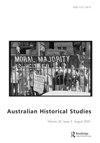Australia’s Great Depression: How a Nation Shattered by the Great War Survived the Worst Economic Crisis It Has Ever Faced
IF 0.6
3区 历史学
Q1 HISTORY
引用次数: 0
Abstract
made her the standout exception. How the Red Cross Societies were forced to engage with a wider section of the community is a recurring motif in this book. Margaret Tennant’s wideranging chapter on the New Zealand Red Cross particularly engages with this issue in a postcolonial context. The impact of modern marketing is yet another common thread. The key example is the American Red Cross (ARC). Branden Little argues that the American public initially rejected the ARC because it was perceived – presumably with good reason – as incompetent and corrupt. He concludes that the later success of the ARC was due to the new art of professional marketing in time for the USA’s entry into World War I in 1917. Little’s statistics, even with a healthy margin for exaggeration, are amazing. During 1917–18, the ARC’s membership increased from 22,000 to 32 million, while at the same time it distributed $US400 million in relief. An explicit challenge to orthodoxy comes from Davide Rodogno’s highly philosophical argument that humanitarianism involves cultural arrogance. Eldrid Mageli offers an empirical example. Her chapter is a confronting analysis of the Norwegian Red Cross’s role in the Biafran famine. Mageli’s conclusion is that ‘short-term alleviation...may have longerterm, harmful consequences’ (175) – and in Biafra’s case, almost certainly did. Mageli shows how leaders can ruthlessly exploit goodwill. Similarly, Rebecca Gill’s study of the ICRC conference in 1938 reveals how expertly the Nazis exploited the Red Cross’s internationalist ideals to promote British proappeasement policies. Caroline Reeves argues that efforts in the late nineteenth century to establish a Red Cross Society in China were because the Red Cross was recognised as a marker of civilisation. Despite the Chinese regime’s lack of interest in humanitarianism, it tried to establish a Red Cross Society to help assert national sovereignty. In this case, government efforts to exploit Red Cross idealism failed, largely due to the Boxer rebellion. This volume offers a scholarly smorgasbord on the impact of the Red Cross. While its small font and almost complete lack of photographs is not reader-friendly, all should find something to add to or challenge their understanding of not just the Red Cross, but the broader history of the late nineteenth and twentieth centuries.《澳大利亚的大萧条:一个被一战摧毁的国家如何度过有史以来最严重的经济危机
使她成为一个突出的例外。红十字会是如何被迫与更广泛的社会群体接触的,这是本书反复出现的主题。玛格丽特·坦南特(Margaret Tennant)关于新西兰红十字会(New Zealand Red Cross)的广泛章节尤其在后殖民背景下探讨了这一问题。现代市场营销的影响是另一个共同的线索。最典型的例子是美国红十字会(ARC)。布兰登·利特尔认为,美国公众最初拒绝ARC,是因为他们认为(可能有充分的理由)ARC无能且腐败。他总结说,ARC后来的成功要归功于1917年美国加入第一次世界大战时专业营销的新艺术。利特尔的统计数据,即使有适当的夸张,也是惊人的。1917年至1918年期间,ARC的成员从2.2万人增加到3200万人,同时分发了4亿美元的救灾物资。对正统的明确挑战来自于大卫·罗多诺(Davide Rodogno)高度哲学化的论点,即人道主义涉及文化傲慢。Eldrid Mageli提供了一个实证例子。她的章节是对挪威红十字会在比夫拉饥荒中所扮演角色的正面分析。马格里的结论是,“短期缓解……可能会有长期的、有害的后果”(175)——而在比夫拉的案例中,几乎肯定是这样的。马格里展示了领导者如何无情地利用善意。同样,丽贝卡·吉尔(Rebecca Gill)对1938年红十字国际委员会会议的研究揭示了纳粹如何巧妙地利用红十字会的国际主义理想来推动英国的绥靖政策。卡洛琳·里夫斯(Caroline Reeves)认为,19世纪后期在中国建立红十字会的努力,是因为红十字被认为是文明的标志。尽管中国政府对人道主义缺乏兴趣,但它试图建立一个红十字会,以帮助维护国家主权。在这种情况下,政府利用红十字会理想主义的努力失败了,这主要是由于义和团运动。这本书提供了一个学术大杂烩对红十字会的影响。虽然它的字体很小,几乎完全没有照片,对读者来说并不友好,但所有人都应该找到一些东西来增加或挑战他们对红十字会的理解,不仅是对红十字会的理解,还有对19世纪末和20世纪更广泛历史的理解。
本文章由计算机程序翻译,如有差异,请以英文原文为准。
求助全文
约1分钟内获得全文
求助全文
来源期刊

AUSTRALIAN HISTORICAL STUDIES
HISTORY-
CiteScore
0.70
自引率
16.70%
发文量
86
期刊介绍:
Australian Historical Studies is a refereed journal dealing with Australian, New Zealand and Pacific regional issues. The journal is concerned with aspects of the Australian past in all its forms: heritage and conservation, archaeology, visual display in museums and galleries, oral history, family history, and histories of place. It is published in March, June and September each year.
 求助内容:
求助内容: 应助结果提醒方式:
应助结果提醒方式:


